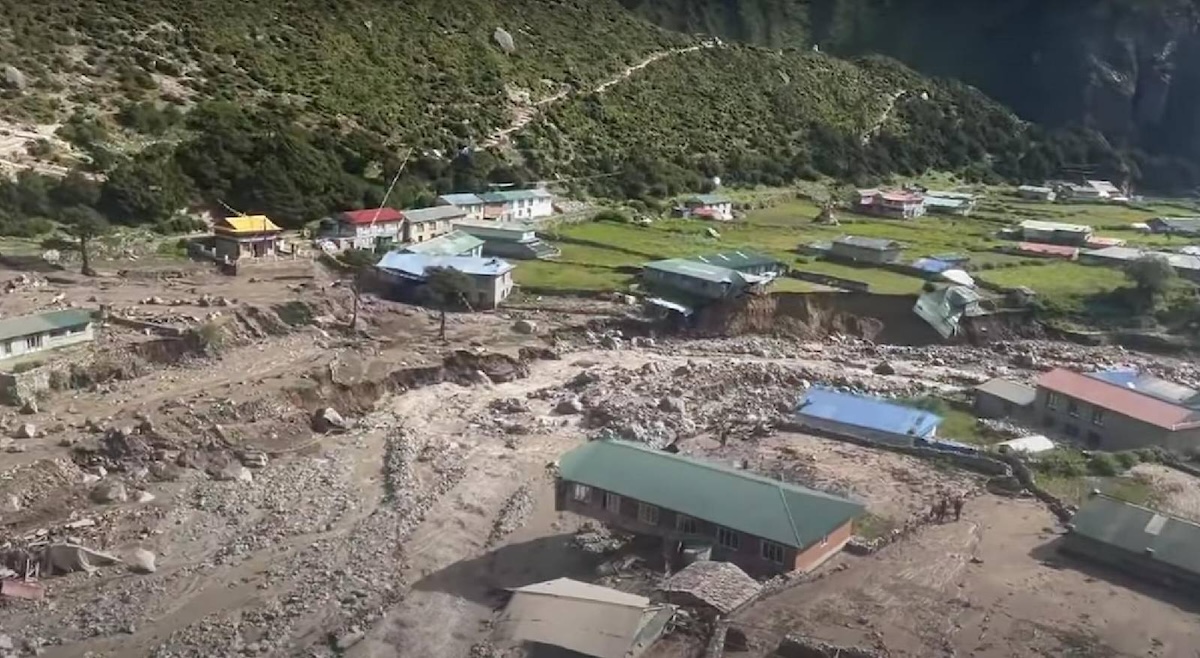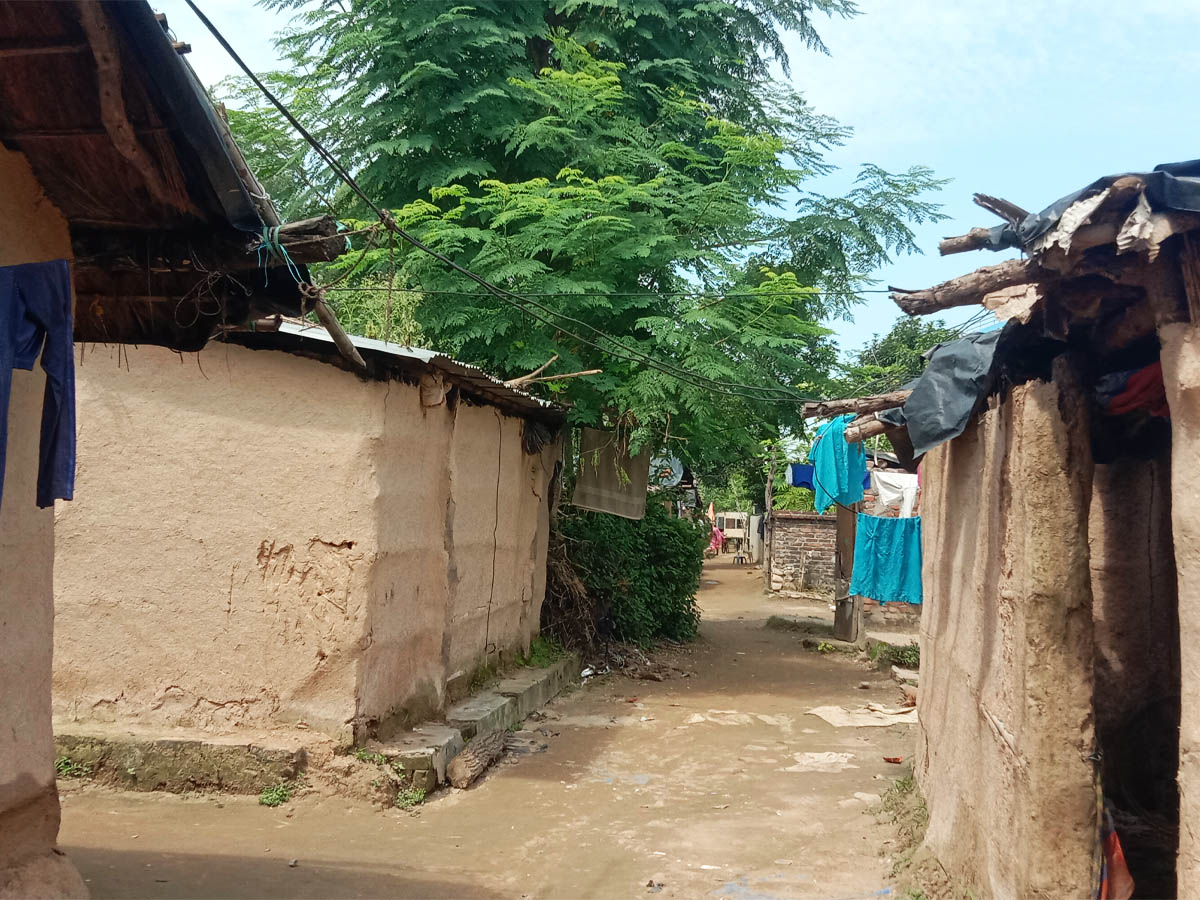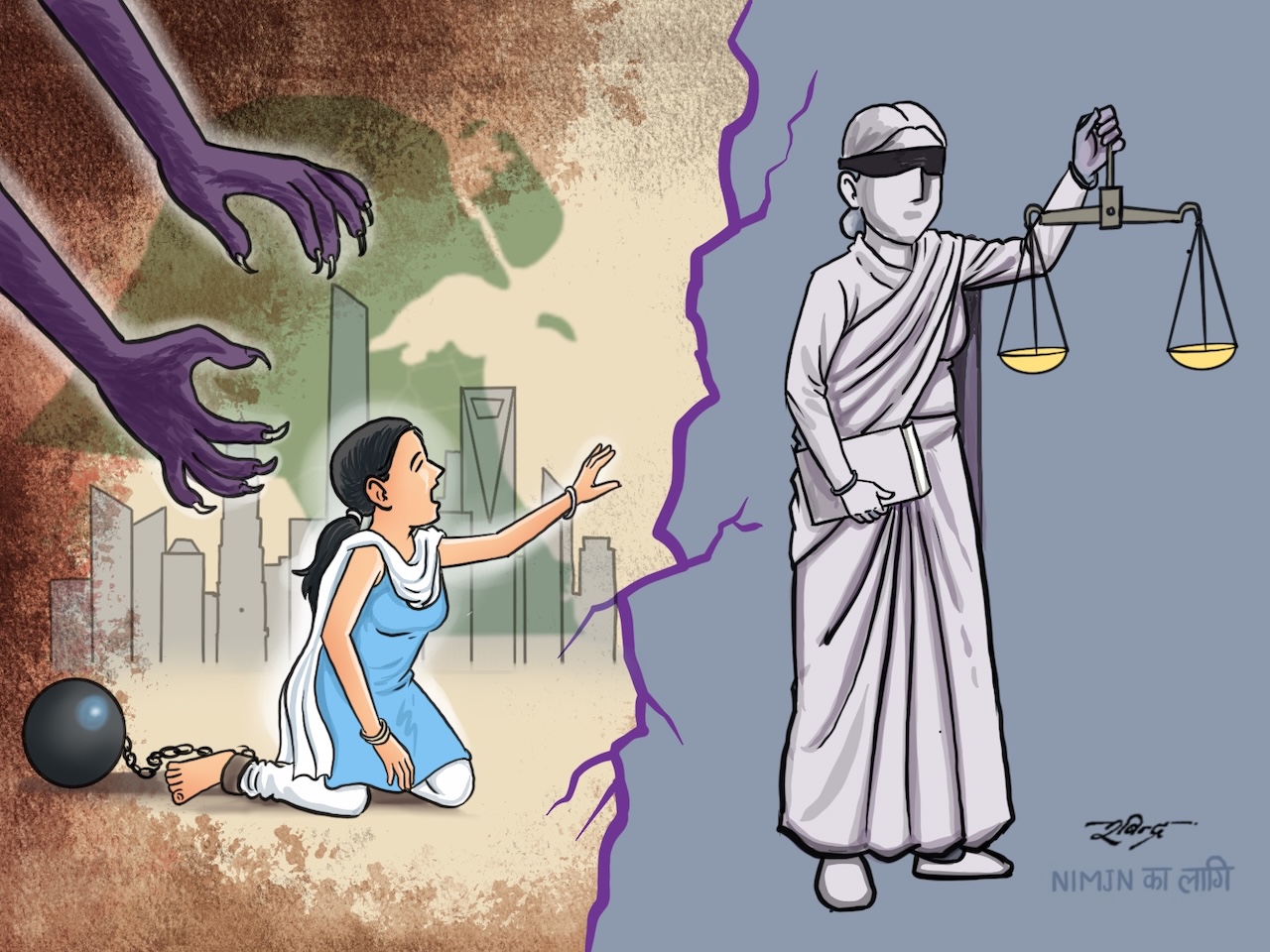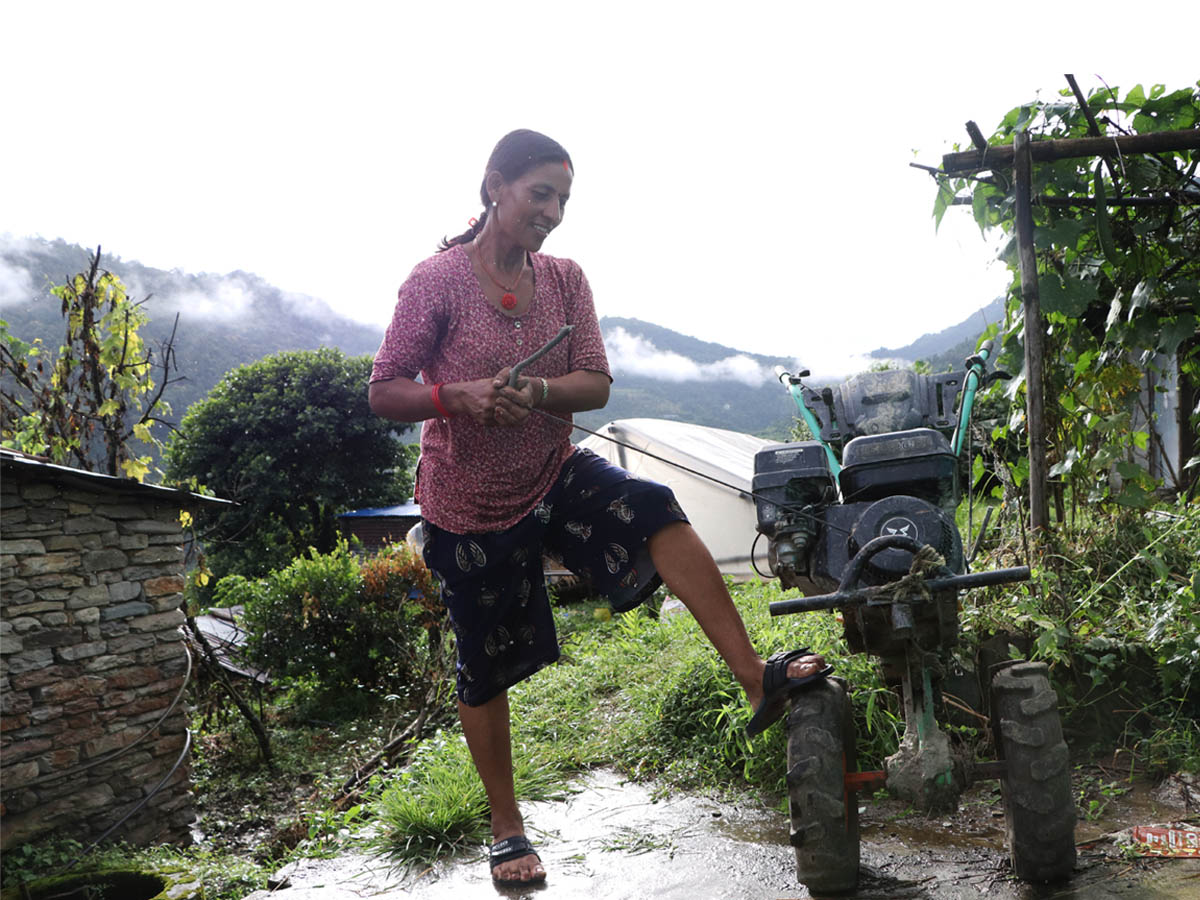Around 13:30 on August 16, 2024, a sudden mudslide triggered a devastating flood in Thame Bazaar of Solukhumbu district. Local residents were forced to evacuate to higher ground to save their lives. The flood, believed to have been caused by the rupture of a glacial lake, resulted in significant damage to houses, hotels, schools and a health clinic.
 "The previous flood mainly affected the lower areas," said Fulmaya Kami, a 60-year-old ward member of Khumbu Pasang Lhamu Rural Municipality-5, who witnessed both floods. "But this time, Thame was completely devastated."
"The previous flood mainly affected the lower areas," said Fulmaya Kami, a 60-year-old ward member of Khumbu Pasang Lhamu Rural Municipality-5, who witnessed both floods. "But this time, Thame was completely devastated."
Following the flood, Anil Pokharel, Chief Executive Officer of the National Disaster Risk Reduction and Management Authority, conducted a field visit and confirmed that the sudden flood in Thame was caused by the rupture of a glacial lake. He explained that two glacial lakes in the upper reaches of the Thame River had burst. A small landslide on the wall of the upper lake triggered the release of water into the lower lake, which subsequently burst and caused the devastating flood. The fragile geography of the region, characterized by loose soil, amplified the impact of the flood as the eroded sediment mixed with the water.
The flood in Thame is not an isolated incident; it is a direct consequence of climate change. The rising global temperature is causing glaciers and glacial lakes in the Himalayan region to melt at an accelerated rate, increasing the risks of floods and other disasters. Experts warn that if this trend continues, there may be water scarcity and other adverse impacts during the dry season in the future.
Mingma David Sherpa, a mountaineer who first summited Mount Everest in 2010, has personally witnessed these changes. Having successfully climbed Everest 7 times in 14 years, he has observed significant alterations in glaciers and glacial lakes. He noted the appearance of previously hidden dark rocks in areas that were once covered in snow. "Glaciers on Everest are melting rapidly, and water flow is increasing," he said. "Glacial lakes that were visible the previous year have disappeared the following year."
This was not the first time Thame had faced such a catastrophe. A similar flood occurred in 1985, although the primary damage was concentrated downstream.
Sherpa also pointed out changes in snowfall patterns. "Snowfall is occurring at irregular times, and even when it does snow, it doesn't stay frozen for long. The snow cover is thinning," he explained. "The old snow is melting and the bare patches are not getting refrozen."

Fu Chhatra Sherpa, another eyewitness who has been observing changes in the snow cover in the Himalayan region, corroborates these observations. He noted that the snowline has been receding, and now snow is primarily found in the higher reaches of the mountains. Sherpa, who has been involved in trekking and climbing since 2012, has observed significant changes in the rate of glacier melting in recent years. "The reduced snow cover makes it difficult to set anchors, increasing the risk of rockfalls," he said.
Every year, Mingma David Sherpa reaches the base camp (Island Peak) of Imja Himal in the Khumbu region. He has observed a significant change over the years: Places that used to be covered in thick snow are now exposed rocks. He also recalls witnessing avalanches on paths that were previously safe to traverse. The experiences of these two Sherpa climbers, Mingma David Sherpa and Fu Chhatra Sherpa, align perfectly with the findings of the annual Snow Update Report by the International Centre for Integrated Mountain Development (ICIMOD).
According to ICIMOD's 22-year-long Snow Update Report, the Hindu Kush Himalayan region experienced the lowest snow cover in 2018. The second lowest snow cover was recorded in 2024. Out of the 22 years of the study, the region experienced below-average snow cover in 13 years.
The Hindu Kush Himalayan region, stretching from Myanmar in the east to Afghanistan in the west, is the source of Asia's major rivers. These rivers sustain the lives of 1.65 billion people. The study revealed that 10 out of the 12 most important and large river systems in this region (Amudarya, Indus, Ganges, Brahmaputra, Irrawaddy, Mekong, Yangtze, Helmand, Tarim and the Tibetan Plateau) have experienced below-average snow cover in their basins. This poses a significant threat to the water security of downstream communities, as highlighted in the ICIMOD study.
Nepal is heating up
A study published by the Department of Hydrology and Meteorology in 2017 -showed that Nepal's annual maximum temperature has been increasing at a rate of 0.056 degrees Celsius. The study, which analyzed temperature and rainfall data from 1971 to2014, revealed an increase of more than 2 degrees Celsius in 40 years. The department's data indicates that the impact of temperature rise is even more pronounced in the mountains.
According to the department, the temperature has been increasing at a rate of 0.086 degrees Celsius per year in the Himalayas, 0.068 degrees Celsius in the high mountains, 0.052 degrees Celsius in the mid-hills, 0.030 degrees Celsius in the Shivalik region, and 0.021 degrees Celsius in the Terai.
Dr. Santosh Nepal, a researcher at the International Water Management Institute, explains that as the temperature rises, the land surface also heats up, causing snow to melt faster.
A study by the US National Oceanic and Atmospheric Administration shows that since the Industrial Revolution began around 1850, the Earth's temperature has increased by an average of 0.11 degrees Fahrenheit (0.06 degrees Celsius) per decade. The year 2023 was the warmest year on record since 1850, and the rate of temperature increase has tripled since 1982.
The 2017 US Climate Science Special Report projected that if carbon emissions continue to rise at the current rate, the global temperature could increase by 5-10.2 degrees Fahrenheit (2.8-5.7 degrees Celsius) by the end of the century.
Over the past six decades, the average temperature in the Hindu Kush region has increased by 0.2 degrees Celsius per decade. Even if the global temperature increases by 1.5 degrees Celsius by the end of this century, the temperature in this region is expected to increase by 2.1 degrees Celsius.
Despite the global agreement to limit the average temperature increase to 1.5 degrees Celsius compared to pre-industrial levels, the Intergovernmental Panel on Climate Change (IPCC) report suggests that this goal is becoming increasingly unattainable. The report calls for a 40% reduction in carbon emissions by 2030, but studies show that emissions are actually increasing by 11-12%.
The IPCC report recommends taking drastic measures to reduce emissions, but achieving the goal of net-zero emissions by 2050 seems improbable based on the current trends.
To limit global warming to 1.5 degrees Celsius, the G20 countries need to reduce their annual per capita carbon emissions by 2.9 to 3.8 tons by 2030, according to an Oxfam report. However, global greenhouse gas emissions are projected to increase further by 2030. A report published on September 7, 2023, estimates a 10.6% increase in emissions by 2030.
G20 countries are considered the primary contributors to greenhouse gas emissions, accounting for 78% of total emissions. Arun Bhakta Shrestha, the Manager of the River Basin and Cryosphere Regional Program at ICIMOD, believes that G20 countries will fail to achieve the target of limiting global warming to 1.5 degrees Celsius. "The actions taken by member countries and other nations to fulfill their commitments are insufficient," he says. "Based on the current rate of emissions, the temperature could increase by 3.5 degrees Celsius."
Little snow, little water
The primary sources of water are monsoon rains, rainfall and snow. When there is no monsoon, snow becomes the main water source. Some of the winter snow melts immediately, while the rest freezes into ice. As the weather warms, the ice also melts and flows, ensuring a year-round flow in rivers.
However, a decrease in snowfall means a reduction in water storage. Shrestha likens snow to a bank account. Just as a bank balance decreases when income is low and expenses are high, similarly, if there is less snowfall or if the temperature increases causing the snow to melt rapidly, the amount of snow on Earth decreases. A decrease in the bank balance leads to a financial crisis, while a decrease in snow leads to a water crisis. A water crisis, or lack of water, is a very dire situation.
The Asian Development Bank (ADB) report, "Building Resilience and Adaptation in the Hindu Kush Himalaya: Bhutan and Nepal Technical Assistance," also highlights the rapid melting of the world's "third pole" (the snow and ice of the Himalayas). The report states that the climate crisis in the Hindu Kush Himalayan region has turned into a water crisis, affecting everyone.
The Hindu Kush Himalayas, known as the "Third Pole" or "Water Tower of Asia," is the largest store of ice outside the polar regions. However, climate change is depleting this reservoir, negatively impacting water availability for drinking, irrigation, agriculture and hydropower.
Toll on architecture and agriculture
In the villages beyond the Himalayas, where one must look south to see the mountains, houses with mud roofs were once common. These traditional settlements featured a unique architectural style where wooden frames were covered with mud to create roofs. Since rainfall was scarce in these regions, the mud roofs were not affected. However, Pemba Chhiring Gurung from Varagung Muktichhetra Rural Municipality-1 in Mustang reports that excessive rainfall in recent years has caused the roofs to leak.
Gurung is concerned about the decline of traditional Himalayan architecture due to increased rainfall. "Due to heavy rainfall, almost all the old-style houses in the village have started leaking," he said. "Now, some people are using plastic to cover the mud, some are repairing and using tin roofs, and others are building houses using concrete."
He also noted changes in the snowfall patterns in the high Himalayan region. In some years there is extremely heavy snowfall, while in other years there is very little snowfall. The timing of snowfall has also become unpredictable, either occurring earlier or later than usual. These changes have adversely affected the production of apples, potatoes, barley and buckwheat.
The traditional agricultural system in the Himalayan region relies on snow. Snow is the primary source of soil moisture. Shrestha from ICIMOD explains that changes in the timing and amount of snowfall are impacting crop production.
The changes in the timing and duration of snowfall in the Himalayas have both short-term and long-term impacts on local and regional areas. The water from melting snow is used in downstream areas for various purposes, including drinking water, irrigation and hydropower. Shrestha states that fluctuations in snow cover directly affect these sectors.
Risks at downstream
The melting of snow due to rising temperatures is having a significant impact on downstream areas. Even with a current temperature increase of 1.1 degrees Celsius, the frequency of disasters has increased annually. "For us, 1.5 degrees is already too hot. We can't imagine where the disasters would be if it reaches 3.5 degrees," said Shrestha.
Already, downstream areas are experiencing disasters such as the conversion of arable land into barren land and difficulties in irrigation. This poses a risk of reduced production and a cycle of poverty, he warns.
Dr. Nepal suggests that the timing of snowfall will shift a month earlier in the future due to rising temperatures. This will affect communities that rely on water from melting snow. Communities that plant crops during the time when snow melts in winter will be particularly impacted. Overall, the effects observed in snow will have a ripple effect on all water-related sectors.
The recent flood in Thame is a clear example of the impact of rising temperatures. According to a bulletin issued by the Flood Forecasting Division of the Department of Hydrology and Meteorology on the evening August 16, 2024, the temperature had increased before the flood occurred.
Data from the temperature monitoring station in Phortse, near Thame, showed that the average daily temperature increased from 9.7 degrees Celsius to 11 degrees Celsius from August 9, 2024, and the maximum temperature reached 15.9 degrees Celsius on August 15, 2024. The Phortse station recorded 65 millimeters of rainfall in seven days.
Similarly, Shrestha suggests that snow played a role in the 2021 Melamchi flood. According to him, the Melamchi flood originated in the upper regions. There was a period of heavy snowfall followed by a significant amount of rainfall while the snow was still frozen, coupled with warmer temperatures.
"When it rains on snow, the snow melts. The amount of water from the melted snow, the rain and the additional melted water due to the heat was excessive," he said. "This caused a small lake to burst. A little further down, a landslide blocked the river, and after some time, it burst, leading to a devastating flood."
According to him, the sediment brought from upstream accumulated to a height of 8 to 12 meters in the flat areas. This resulted in damage to Melamchi's agricultural land, settlements and businesses along the riverbank. Floods have become a recurring problem in Melamchi. Studies conducted by the Department of Geology at Tribhuvan University have warned that the risk of floods in Melamchi still persists.
Efforts to save the Himalayas
The Himalayas are often referred to as the "cooling center" of the Earth. However, studies by the Department of Hydrology and Meteorology indicate that the Himalayas themselves are warming due to rising temperatures. Not only in Nepal, but also in other parts of the world, the mountains are experiencing disasters caused by rising temperatures. Despite this, Shrestha points out that the issue of preserving the Himalayas has not yet been fully recognized as a key issue in the COP (Conference of the Parties) discussions. Although Nepal, Bhutan and other countries have shown solidarity on Himalayan issues, developed nations have not fully acknowledged these concerns.
The Rio Summit's agenda, which was adopted three decades ago, recognized the impact of rising temperatures on the Himalayas. Agenda 21 of the 1992 Rio Summit, agreed upon by 121 countries including Nepal, included sustainable development in the Himalayan region.
However, for 15 years after the Rio Summit, this issue did not receive significant attention at COP meetings. It was only in 2009-2010 that the "Mountain Innovative" workshop was held. After that, there were no discussions on Himalayan issues for five years. In 2015, at COP 21, the issue of glaciers was raised, and Nepal had the opportunity to present its concerns, according to Buddhisagar Poudel, Chief of the Climate Change Division.
Sustainable Development Goal 13, which focuses on climate action, was included in the 2016-2030 Sustainable Development Goals. Nepal's 13th plan allocated a budget for climate change, and the 15th plan established long-term goals and objectives in this regard. Additionally, the National Adaptation Program and Local Adaptation Programs were implemented in 2019.
In recent years, Nepal has been raising the issue of the Himalayas at COP meetings since 2021 due to the increasing frequency of unnatural disasters in the country. Poudel mentioned that Nepal prioritized the Himalayan issue at COP 28 as well. However, he emphasized that Nepal needs the support of other countries to establish the Himalayas as a central issue in COP discussions.
Poudel informed that Bhutan and Kyrgyzstan supported the issues raised by Nepal at the COP 28 Bonn discussions. "It is a good idea for Nepal to raise the issue of a 'Mountain Dialogue' at COP," said Shrestha of ICIMOD. "We need to involve multiple stakeholders to create a diverse range of voices."
He emphasized that it is essential to never forget that the support of developed countries is crucial for preserving the Himalayas. Shrestha believes that by gaining global recognition for the impacts and challenges faced by the Himalayas, it will be possible to mobilize resources for its conservation.
Both Shrestha and Poudel agree that the visit of UN Secretary-General António Guterres to Nepal from October 25-28, 2023 during which he visited climate-affected areas such as Mount Everest, Annapurna Base Camp, Pokhara and Lumbini, has made it easier for Nepal to raise the Himalayan issue.
Poudel also cites the "Mountains, People, and Climate Change" international dialogue held in Kathmandu on May 24-25, 2024, and the Cabinet meeting held at Kala Patthar on December 4, 2009as examples.
Good policies, poor implementation
Nepal signed the United Nations Framework Convention on Climate Change in 1994. As part of the Paris Agreement, the Nepali government has developed a National Adaptation Plan (2021-2050) to address climate change adaptation needs.
This plan incorporates 64 adaptation programs, including 8 thematic and 4 intersectoral areas identified in the National Climate Change Policy, 2019.
The government estimates that implementing these programs will require US$ 47.4 billion by 2050. Nepal has identified the problems, but Dr. Nepal points out that there is no clear strategy for implementing the National Adaptation Plan at the local level.
Shrestha of ICIMOD states that while the adaptation policy is good, the government has failed in its implementation plan. He adds that it is a common problem in Nepal to have good policies but poor implementation, saying, "We are far behind in climate action. We rely on donors and create adaptation plans using the funds provided."
According to Shrestha, there is a lack of scientific research and detailed studies in Nepal. Monitoring is also inadequate. The lack of data and the reluctance to acknowledge known facts have contributed to the worsening effects of climate change. Shrestha says, "Nepal is living in a risky situation. We are developing in a risky manner. We are building infrastructure, but we don't have enough evidence to claim that this is the cause of the risk."
Buddhisagar Poudel, the Chief of the Climate Change Division, agrees with Shrestha's assessment. The National Disaster Risk Reduction and Management Authority (NDRRMA) is collecting data, but Poudel acknowledges that it is not sufficient. He mentions that while there is data on economic and non-economic losses in Nepal, the details are lacking. He further states that they are working on a new plan to improve data collection.
"We need to improve our internal preparedness. We need to maintain better data, scientifically prove climate-related problems, and be ready for quick and easy access," Poudel said. "Currently, Nepal has a limited number of meteorological stations, especially in the Himalayan region."
He has experienced firsthand the challenges in data collection due to the time it takes to repair broken stations. He emphasizes the need to develop research and study capacities to create policies for preserving the Himalayas. Poudel adds that by giving equal political priority to climate change issues, Nepal can advocate for them more forcefully. "We need to continue working on this. This is just the beginning," he says.
Shrestha points out that Nepal's participation in COPs is commendable, as it highlights the country's vulnerability. He compares Nepal's situation to Bangladesh, which has been seeking compensation for climate change impacts for a long time. However, he notes that Nepal lacks the same level of preparedness and consistency as Bangladesh. Shrestha attributes this to political instability in Nepal, which leads to frequent administrative changes and impacts the implementation of such plans.
Poudel, the head of the Climate Change Division, states that the effects of current emissions will persist for the next 30 years. He explains that we are currently requesting resources to adapt to the immediate impacts that we are witnessing.
At COP 27, a loss and damage fund was established. In COP 28, there was an agreement to contribute US$ 66.1 million to this fund. However, the process for affected countries to access funds from this pool has not yet been finalized. "Accessing resources from this fund is not so easy. Initially, one must claim to be a victim of climate-related events," Poudel says. "For this, evidence (records, data) is required."
The temperature rise in the Hindu Kush Himalayan region is higher than in other places. "To increase the amount of snow in the Himalayas and prevent continuous risks, we need to reduce the temperature," he says. "Nepal alone cannot reverse the changes occurring in the Himalayas." Therefore, Nepal has been emphasizing the need for developed countries to reduce their carbon emissions to limit the temperature increase to 1.5 degrees Celsius, Poudel adds.
What next?
Researchers warn that reduced snowfall and changing snow levels pose a significant risk, particularly water scarcity. Miriam Jackson, Senior Cryosphere Specialist at ICIMOD, and Sher Mohammad, Cryosphere Specialist, suggest storing water, considering the potential water shortage in downstream communities. Jackson emphasizes the need for awareness programs in communities about the problems caused by reduced snowfall and adaptation measures. This will help affected people find alternative solutions and manage resources.
According to Mohammad, crops can be cultivated based on water availability and low-water-demanding crops can be prioritized. The ICIMOD study highlights the immediate need for support to adapt to the changing snow patterns affected by carbon emissions. The study suggests that G20 countries need to reduce emissions to prevent further disasters.
Dr. Nepal points out that the impacts we are experiencing on snow and glaciers are due to carbon emissions from developed countries. He believes that adaptation is the only viable option in the current situation. Adaptation requires a significant amount of funding, which should be provided by developed countries to developing nations. Nepal has been demanding compensation but developed countries have not fulfilled their commitments.
Dr. Nepal feels that there is a need for a national-level roadmap, capacity building, and infrastructure to maximize the utilization of climate finance. "Adaptation cannot be imagined without water. However, our policies have not adequately considered the role of water in both adaptation and mitigation," he said.
Read Our Republishing Policy here.



